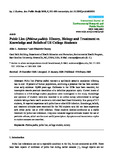Pubic Lice (Pthirus pubis): History, Biology and Treatment vs. Knowledge and Beliefs of US College Students
Author
Anderson, Alice L.; Chaney, Beth H.
Abstract
Pubic lice (Pthirus pubis) maintain a worldwide parasitic population infesting two to over 10 percent of human populations, continuing a presence that has been constant since early evidence 10,000 years ago. Outbreaks in the 1970s have been recorded, but incomplete records preclude description of a definitive population cycle. Current levels of infestation in a US college student population were investigated in this study. Knowledge and opinions of students were also recorded in an online survey administered to college students taking a basic health course at a mid-sized East Coast University. In a group of 817 students, 35 reported experience with pubic lice or other STD infection. Knowledge, beliefs, and treatment attitudes were examined for the 782 students who did not have experience with either pubic lice or STD infection. These students deemed antibiotics as a viable treatment for pubic lice infestation. They also indicated negative attitudes toward the use of pesticide crèmes, which are the most useful prescription. Symptoms and transmission myths in student answers are described. Publisher's version available at: http://www.mdpi.com/1660-4601/6/2/
Subject
Date
2009-02
Citation:
APA:
Anderson, Alice L., & Chaney, Beth H.. (February 2009).
Pubic Lice (Pthirus pubis): History, Biology and Treatment vs. Knowledge and Beliefs of US College Students.
International Journal of Environmental Research and Public Health,
6(2),
592-
600. Retrieved from
http://hdl.handle.net/10342/2991
MLA:
Anderson, Alice L., and Chaney, Beth H..
"Pubic Lice (Pthirus pubis): History, Biology and Treatment vs. Knowledge and Beliefs of US College Students". International Journal of Environmental Research and Public Health.
6:2. (592-600),
February 2009.
April 19, 2024.
http://hdl.handle.net/10342/2991.
Chicago:
Anderson, Alice L. and Chaney, Beth H.,
"Pubic Lice (Pthirus pubis): History, Biology and Treatment vs. Knowledge and Beliefs of US College Students," International Journal of Environmental Research and Public Health 6, no.
2 (February 2009),
http://hdl.handle.net/10342/2991 (accessed
April 19, 2024).
AMA:
Anderson, Alice L., Chaney, Beth H..
Pubic Lice (Pthirus pubis): History, Biology and Treatment vs. Knowledge and Beliefs of US College Students. International Journal of Environmental Research and Public Health.
February 2009;
6(2):
592-600.
http://hdl.handle.net/10342/2991. Accessed
April 19, 2024.
Collections
Publisher
East Carolina University

